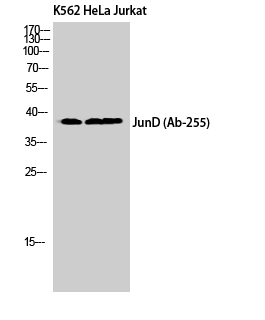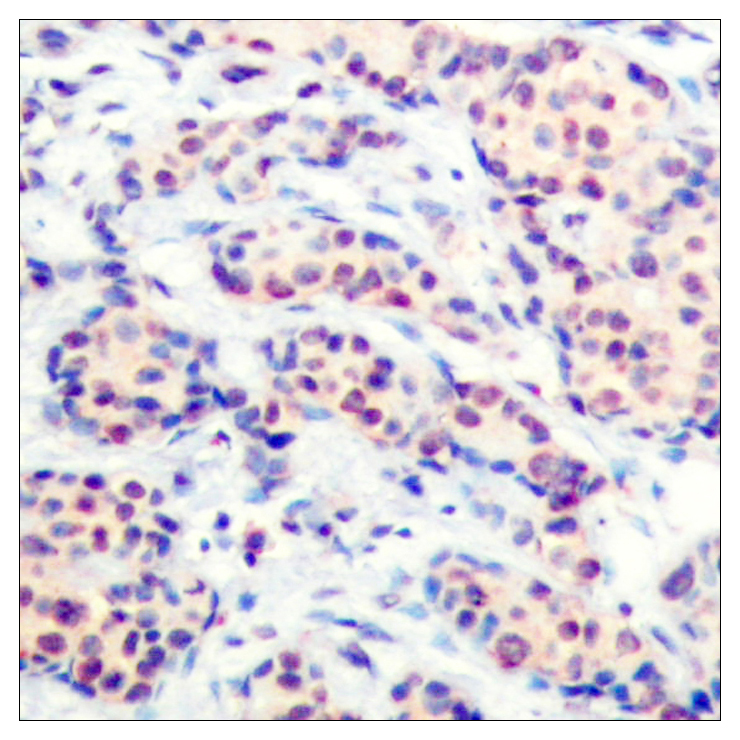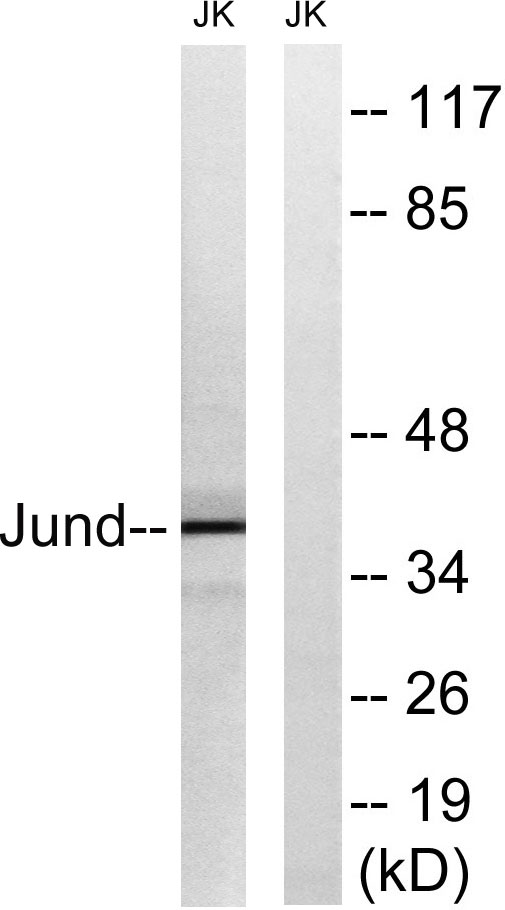Jun D Polyclonal Antibody
- Catalog No.:YT2447
- Applications:WB;IHC;IF;IP;ELISA
- Reactivity:Human;Mouse;Rat
- Target:
- Jun D
- Fields:
- >>MAPK signaling pathway;>>Osteoclast differentiation;>>IL-17 signaling pathway;>>Parathyroid hormone synthesis, secretion and action
- Gene Name:
- JUND
- Protein Name:
- Transcription factor jun-D
- Human Gene Id:
- 3727
- Human Swiss Prot No:
- P17535
- Mouse Gene Id:
- 16478
- Mouse Swiss Prot No:
- P15066
- Rat Gene Id:
- 24518
- Rat Swiss Prot No:
- P52909
- Immunogen:
- The antiserum was produced against synthesized peptide derived from human JunD. AA range:222-271
- Specificity:
- Jun D Polyclonal Antibody detects endogenous levels of Jun D protein.
- Formulation:
- Liquid in PBS containing 50% glycerol, 0.5% BSA and 0.02% sodium azide.
- Source:
- Polyclonal, Rabbit,IgG
- Dilution:
- WB 1:500 - 1:2000. IHC 1:100 - 1:300. Immunoprecipitation: 2-5 ug:mg lysate. ELISA: 1:20000.. IF 1:50-200
- Purification:
- The antibody was affinity-purified from rabbit antiserum by affinity-chromatography using epitope-specific immunogen.
- Concentration:
- 1 mg/ml
- Storage Stability:
- -15°C to -25°C/1 year(Do not lower than -25°C)
- Other Name:
- JUND;Transcription factor jun-D
- Observed Band(KD):
- 38kD
- Background:
- The protein encoded by this intronless gene is a member of the JUN family, and a functional component of the AP1 transcription factor complex. This protein has been proposed to protect cells from p53-dependent senescence and apoptosis. Alternative translation initiation site usage results in the production of different isoforms (PMID:12105216). [provided by RefSeq, Nov 2013],
- Function:
- function:Binds an AP-1 site and upon cotransfection stimulates the activity of a promoter that bears an AP-1 site.,similarity:Belongs to the bZIP family. Jun subfamily.,similarity:Contains 1 bZIP domain.,subunit:Binds DNA as a dimer.,
- Subcellular Location:
- Nucleus.
- Expression:
- Epithelium,Spleen,
JunD functions as a transcription factor of IL-10 to regulate bacterial infectious inflammation in grass carp (Ctenopharyngodon idella) INTERNATIONAL JOURNAL OF BIOLOGICAL MACROMOLECULES Hong Yang IF Grass carp 1:200 spleen leukocytes
Exercise Alleviates Fluoride-Induced Learning and Memory Impairment in Mice: Role of miR-206-3p and PREG BIOLOGICAL TRACE ELEMENT RESEARCH Chai Lei WB Mouse 1:1000 HT-22 cell
A specific GAGTT insertion/deletion variation in the IL-10 gene promoter alters the disease resistance of grass carp AQUACULTURE Hong Yang WB,Pull Down Fish 1:1000 spleen tissue
- June 19-2018
- WESTERN IMMUNOBLOTTING PROTOCOL
- June 19-2018
- IMMUNOHISTOCHEMISTRY-PARAFFIN PROTOCOL
- June 19-2018
- IMMUNOFLUORESCENCE PROTOCOL
- September 08-2020
- FLOW-CYTOMEYRT-PROTOCOL
- May 20-2022
- Cell-Based ELISA│解您多样本WB检测之困扰
- July 13-2018
- CELL-BASED-ELISA-PROTOCOL-FOR-ACETYL-PROTEIN
- July 13-2018
- CELL-BASED-ELISA-PROTOCOL-FOR-PHOSPHO-PROTEIN
- July 13-2018
- Antibody-FAQs
- Products Images

- Western Blot analysis of K562 HeLa Jurkat cells using Jun D Polyclonal Antibody cells nucleus extracted by Minute TM Cytoplasmic and Nuclear Fractionation kit (SC-003,Inventbiotech,MN,USA).

- Immunohistochemistry analysis of paraffin-embedded human breast carcinoma tissue, using JunD Antibody. The picture on the right is blocked with the synthesized peptide.

- Western blot analysis of lysates from Jurkat cells, using JunD Antibody. The lane on the right is blocked with the synthesized peptide.



